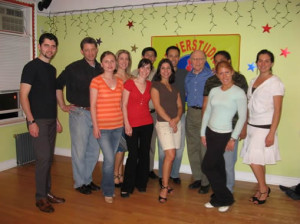
Group salsa class in Park Slope Brooklyn
You want to become a dance teacher. You see lots of different dance teacher training programs, but aren’t sure how to choose a good one. Here are some tips. If you want to work consistently and make a living as a full-time dance teacher, the more dances you know, the better. If all you know is salsa on2 or Argentine tango it will be difficult to keep yourself employed. Owning two Brooklyn dance studios, I get resumes and calls everyday from professional salsa dancers, professional Argentine tango dancers, belly dancers, international Latin and ballroom dancers looking for work. The first thing I ask them is, do they know any other dances or styles? If the answer is no, I will have a hard time employing them.
Dance schools want dancers who are well-rounded. It’s great to be an expert in one dance, but know some others. I just got a resumes from a dancer who’s been dancing for 15 years and all she knows is salsa on2. In 15 years she couldn’t pick up some other dances?
Here’s a typical day for me and any of my dance teachers. Yesterday at 9am I taught a private at our Flatbush dance school. The student is doing hustle, salsa on1, and bachata. At 10 I taught an Argentine tango private. At 3 I went to our Park Slope studio and taught a private bachata lesson. This student also wants to learn cumbia. At 7 I teach a couple who is doing social ballroom. At 8 we have a two-hour intermediate salsa class. Where would I be if I only knew how to dance one dance or style? A dance student frequently starts leaning one dance, then become interested in a different dance. If all you know is that one dance, you will lose them as a student when they want to move on to a different dance.
Also, a school would rather have one teacher doing two hours than two separate teachers each doing an hour each. It’s just easier. So, make sure the teacher training program is making you into a well-rounded dancer. This way no matter what a student wants to learn, you will be the go to dance teacher for that studio.
Is there any kind of placement program? It’s great that they are training you in salsa on1, salsa on2, Argentine tango, Latin and ballroom, hustle and wedding choreography; making you into a well-rounded dancer. But what happens when you’re done with your training? Do they have work for you? Consider this. The dance training program that has work for you is the one you should choose.
Do they teach you how to teach or just how to dance? Many great dancers don’t know how to teach. The teachers who last and make a good living, are the ones who know how to teach and not just dance. You will be getting lots of different types of students. You don’t want to teach each one the same. Some are very serious about dance and dancing well. Most are not interested in become professional dancers, and are just doing if for fun. Teach the right way and you will keep your student and get more.
Do they teach you about the business end? What good is it if you know all the dances and how to teach, but can’t get any business. Even if you’re not interested in opening up your own dance studio, knowing sales and how to get students is important. I see some of the best dancers starving for work. Not having any idea how to generate business and keep themselves employed.
Consider all these things when choosing a dancer teacher training program.



